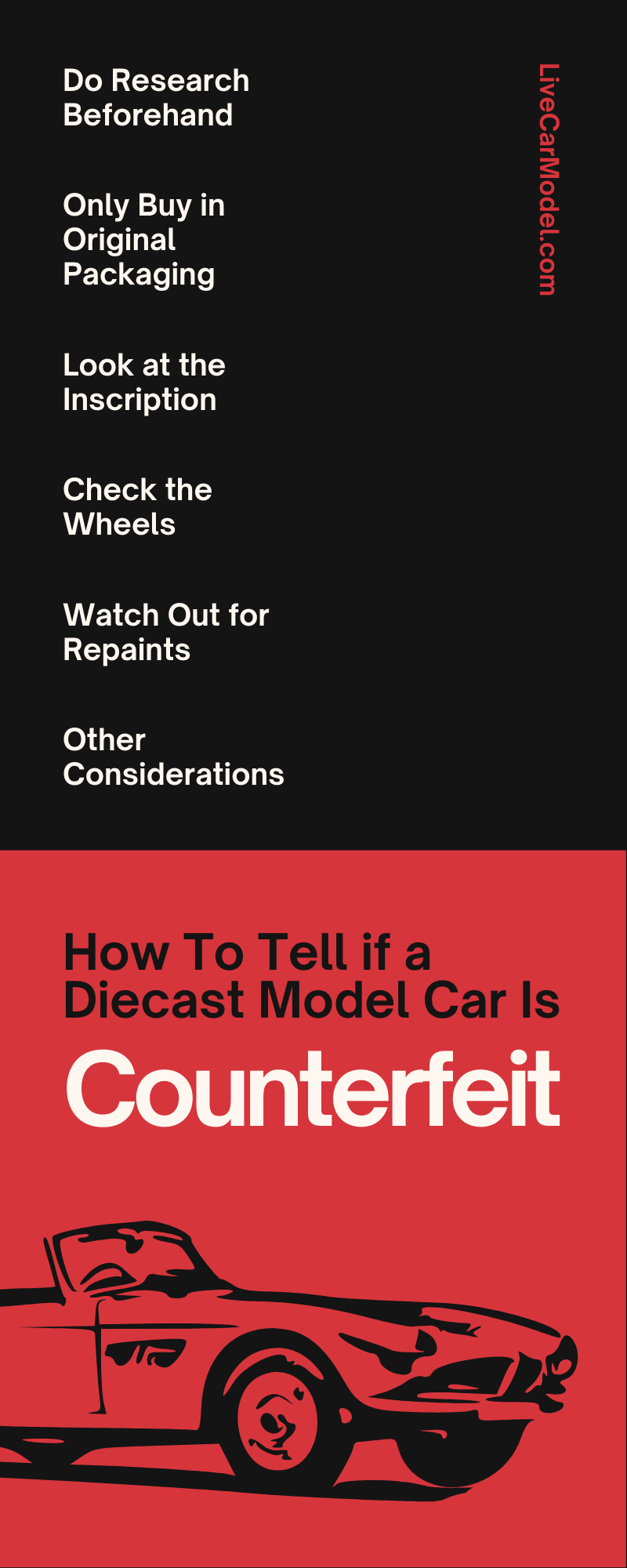Diecast cars are a popular collectible, with some models fetching quite a bit of money. From a few hundred dollars to over seven million, the most popular models are highly sought-after by collectors from all walks of life. Unfortunately, with all the enthusiasm for rare designs, some have turned to counterfeits to make a quick profit.
Finding your favorite model for a reasonable price can seem too good to be true—and usually, it is. However, keeping track of everything to look for can be difficult for beginners. If you want to know how to tell if a diecast model car is counterfeit, read on for some best practices that will help you spot a fake.
Do Research Beforehand
Going into your purchase blindly is a sure way to get ripped off. Remember, don't get overexcited and spend money without doing your research. There's quite a bit of information about each model, and manufacturers will usually provide guides for learning about the ins and outs of their products.
Knowing the model you want inside and out will give you a clear picture of what you're looking for from a seller. Create a clear plan of action that outlines all the essential parts of the model and how they might have worn or been replaced to see how it affects the value. Go through a step-by-step inspection of each product before you buy it to ensure you don't get stuck with a counterfeit.
Only Buy in Original Packaging
When buying used items, it can be hard to know where they came from or whether they have all of their original parts. The easiest way to ensure a diecast car isn't counterfeit is to get one that's still in its original packaging. This way, you can make sure everything is in order by comparing it to manufacturer specs and any other information you've obtained.
Packaging is especially important for rarer models, so inspect everything together to see if anything seems off. The car's name should be labeled somewhere on the box along with its production number, which tells you how many were produced over its lifetime. Just try to make sure everything is sealed so you know it hasn't been tampered with, and remember that older models won't have boxes that are in perfect condition.
Look at the Inscription
Most diecast cars will have an inscription on the bottom indicating when and where it was manufactured. If the model you're looking at is out of the original packaging, you can flip it over and check the labeling for logos, dates, and crafting codes. Mercedes diecast cars, for example, will have the series, MPN, and vehicle year listed on all their products.
A fake diecast model car might have incorrect or missing information compared to what the manufacturer's data says. However, it can sometimes be challenging to know if this was done on purpose or just because its owners used it a lot. If you have time, take a picture and do some research to make sure everything is correct before moving forward with the transaction.
Check the Wheels
Different wheels can significantly impact a diecast car's value, especially for Matchbox. Counterfeiters will often switch out these parts to artificially increase the value of their products without you knowing. In most cases, it can be hard to catch when sellers use different parts, but with some effort, you can learn how to spot the difference.
Counterfeit wheels are a situation where it's good to have a genuine model to compare to. If you look carefully, you'll notice subtle scratches and markings where parts have been added and removed. Getting an idea of how the customization process works can help you spot a wheel replacement when it's been done to a model you're thinking of buying.
Watch Out for Repaints
Sometimes, sellers will do touchups or other small jobs to a diecast car, which can artificially increase its resale value if collectors don't notice. Repaints are usually done to make standard models look like limited edition models since, in many cases, there are only a few minor cosmetic differences.
If you buy a car with a paint job, you may end up paying much more than it's worth. Catching a counterfeit paint job before it's too late can save you a lot of money. Scratching at a small section of the car with your thumbnail should reveal any additional work that has been done, but it can be harder to know when making your purchase online. For this reason, you should make sure you have a good return policy if you go that route.
Other Considerations
It's important to note that even authentic diecast cars can have scratches or errors, so you need to be aware of how much quality impacts value. Legitimate sellers will display products as-is, so avoid any refurbishes or modifications. Going to a trusted source or website can make a big difference because it usually provides all the necessary documentation up front, allowing you to make your purchase with peace of mind.
If you do purchase from an unknown source, at least make sure they allow returns, and document every step of the exchange so you can get your money back if something is out of place. Counterfeit diecast model cars are all over the market, so finding rare or sought-after items can take time. Take notes during the process, so you have everything you need to make the right decision.
A Good Eye Can Make All the Difference
Knowing how to spot a fake is essential for diecast model collectors. If you're thinking of making a purchase, then learning about common tricks and ways to avoid them beforehand will prevent you from getting ripped off. Finding out for yourself whether a diecast car is counterfeit will allow you to make better decisions when interacting with sellers.
There's no shortage of diecast model cars out there. With all the options available, there are bound to be some unscrupulous dealers taking advantage of unsuspecting enthusiasts. With these tips, you'll have the best diecast model car collection money can buy.


